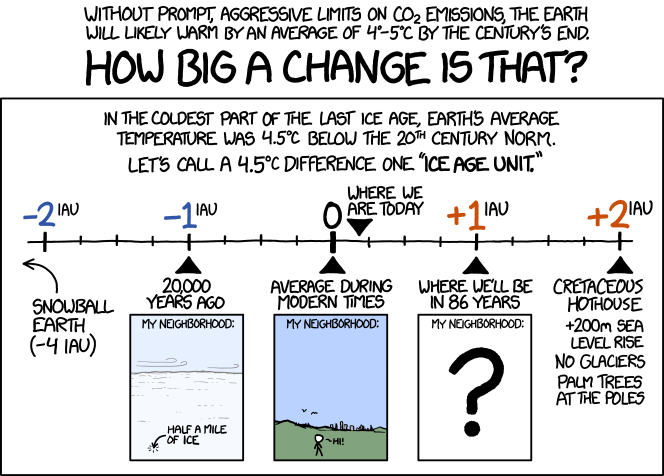A while back, XKCD shared this excellent comic about climate change, proposing the “Ice Age Unit”, or IAU, defined as 4.5 degrees Celsius, and justified as follows:

“The good news is that according to the latest IPCC report, if we enact aggressive emissions limits now, we could hold the warming to 2°C. That’s only HALF an ice age unit, which is probably no big deal.”
This is a pretty good way to think about global climate change, and it’s not actually too far off from how the scientists studying it in the 1890s and early 1900s looked at it as they tried to work out what was up with this whole “ice age” thing that seemed to be in our past. Now, Munroe has given us a much more in-depth look at Earth’s climate, going back to 20,000 BCE, and giving us a pretty good perspective on the current and imminent changes to our global average temperature:


A powerful graph. Quibble: It’s a near-certainty now that habitation of the Americas occurred in multiple waves via land and sea, instead of one singular migration, and very likely included Polynesians colonising South America independently of the land-bridge-and-aleutan-hopping peoples from Siberia. The weight of evidence should be enough to shift consensus on these topics in the next few years, but given the weight of that consensus to date, it is forgivable that such detail isn’t reflected in this sort of compilation.
Excellent, fascinating graphic which is most informative – and puts things powerfully into perspective. Thanks.
A bit off topic,, sorry, but this is historic news somewhat related here too :
http://www.bbc.com/news/science-environment-37351271
Good news or bad – both at the same time but with very worrying implications.
Greg Laden has a good column on this graphic with a few corrections too here :
http://scienceblogs.com/gregladen/2016/09/13/everybody-always-gets-this-wrong-even-smart-people/
Which I think is worth reading and reflecting on.
Off topic but an article of possible interest here for ya :
http://www.bbc.com/news/science-environment-37351271
This strikes me as something which hasn’t been given enough notice – this year’s second lowest Arctic sea ice minimum and its consequences are really quite, well, bloody terrible especially considering what’s in the pipeline as greenhouse gases continue to accumulate and will have a millennia plus (?) lingering impact on our pale blue dot in The Black.
PS. Hope you are okay, Abe Drayton, and are still going to blog here, ideally more frequently, please?